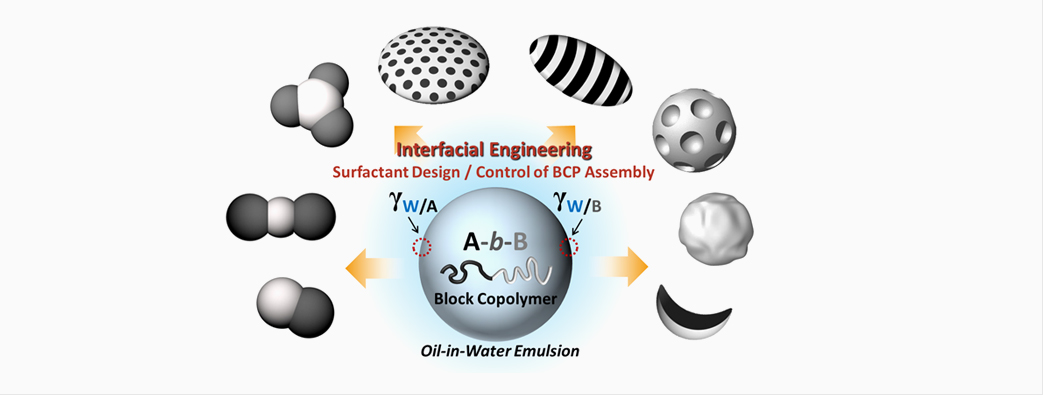- Fabrication of Anisotropic Polymeric Particles through Interfacial Engineering of Block Copolymer Emulsions
Advisor: Bumjoon Kim (bjkim02@kaist.ac.kr)

Shape is one of the most fundamental and essential features that can be imparted on polymeric particles to manipulate their functional behaviors. However, direct synthesis of non-spherical particles is still a great challenge due to the thermodynamic demands to minimize surface area. In an effort to fabricate non-spherical particles, researchers tried to develop various strategies based on the application of external mechanical force to stretch or deform the spherical particles or the use of lithographic technology. However, these methods involve time-consuming and multistep procedure, as well as being expensive and difficult to scale-up for large production. The development of more direct and simpler method for the preparation of non-spherical polymeric particles has been a long-standing goal until date.
In the present work, Kang Hee Ku (Prof. Bumjoon Kim's group) developed a novel platform of interfacial engineering of block copolymer (BCP) emulsions to synthesize polymeric particles with unique shape and nanostructures. The key of this strategy is to create a soft boundary that is neutral to BCPs, which causes spontaneous deformation of water droplets to minimize the free energy penalty associated with bending of the BCP chains. Precise positioning of size- and shape-controlled nanoparticles at the selective and desirable location on the emulsion surface enabled production of convex lens-shaped particles and striped football-shaped particles (JACS, 2014, 136, 9982). Ku and co-workers expanded this interfacial engineering technique in various ways to design other anisotropic polymer particles utilizing the self-assembly property of BCPs. In one application, BCP particles of different geometric structures such as snowman, dumbbell, triangular, and raspberry-shaped structures, were obtained by confining BCPs inside emulsions of few hundred nanometers (ACS Nano, 2015, 9, 11333). In addition, they found that by tuning the interfacial instability of amphiphilic BCP droplets, porous BCP particles with controllable morphology and pore sizes can be obtained (ACS Nano, 2016, 10, 5243). More recently, they designed temperature-responsive polymer surfactants which allow the reversible temperature-driven transformation of anisotropic particle shape (Adv. Mater., 2017, 29, 1700608). This simple strategy of BCP self-assembly within interface-engineered emulsion droplets provides a convenient and robust tool to predict and engineer particle structure to meet the specific needs of different applications.





